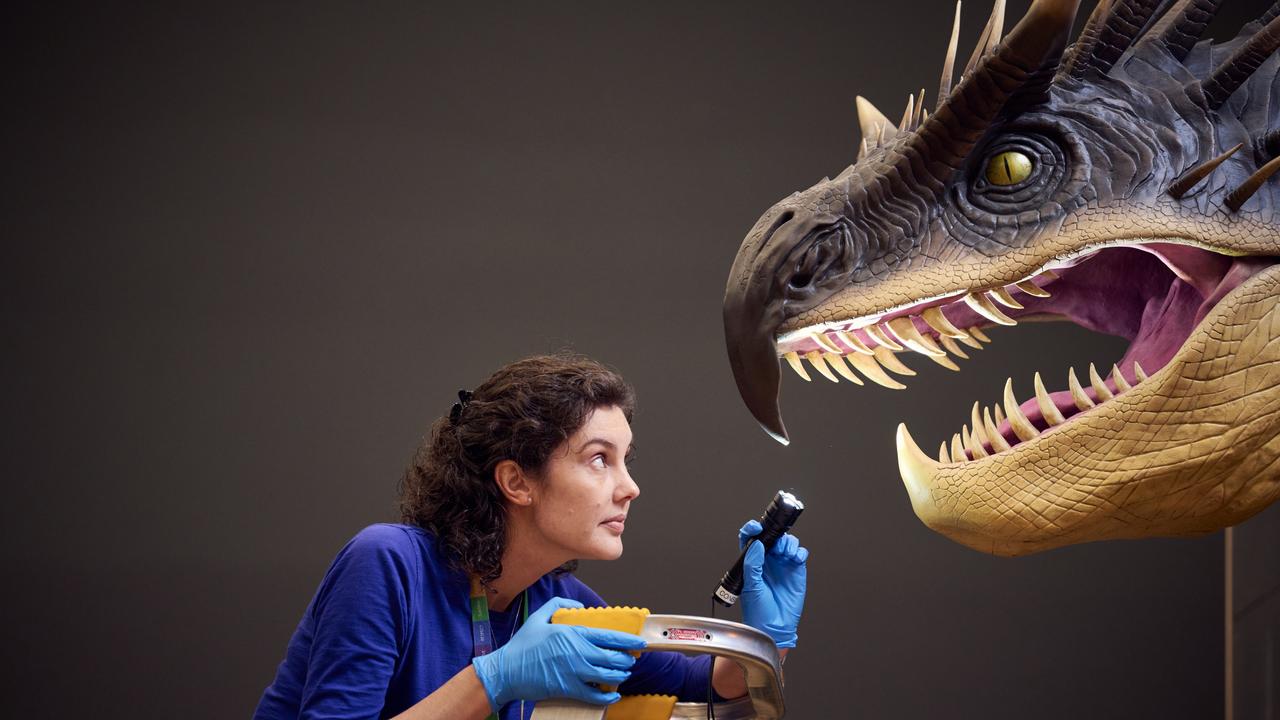Dinosaur fossil Dracorex Hogwartsia to spellbind Australia
A 66-million-year-old dinosaur fossil has arrived in Australia as part of a new exhibition inspired by the Harry Potter universe

READING LEVEL: GREEN
The “dragon king of Hogwarts” – a 66-million-year-old dinosaur fossil* – will reign over Melbourne Museum as part of a new exhibition inspired by the Harry Potter universe.
Dracorex Hogwartsia is a standout feature of Fantastic Beasts: The Wonder of Nature, which makes its Australian debut on May 19 after spellbinding* audiences in the UK and Canada.
The exhibition explores links between the creatures and “magizoologist” Newt Scamander from JK Rowling’s Wizarding World, and the remarkable real-life animals, explorers and zoologists* that inspired them.

Its aim is to conjure* within visitors “a new-found sense of curiosity and admiration for the natural world, as well as a desire to protect it”, said Anna Darron of London’s Natural History Museum, which developed the exhibition with Warner Bros and BBC Studios’ Natural History Unit.
“Fantastic Beasts: The Wonder of Nature is a celebration of the many incredible animals we are lucky enough to share our planet with,” Ms Darron said.
“It also highlights the fact that, like in the Wizarding World, many species face very real threats.
“We hope (to) inspire a greater connection with the natural world and empower* visitors to become advocates* for the planet.”

Dracorex Hogwartsia is one of 65 priceless specimens* on display at Melbourne Museum until October 8, alongside 28 props from the Harry Potter and Fantastic Beasts movies.
The pachycephalosaur fossil from the end of the Cretaceous Period* was discovered in South Dakota’s Hell Creek Formation in 2004.
Scientists named it in honour of the fictional* Hogwarts School of Witchcraft and Wizardry, said Melbourne Museum director of exhibitions and audience experience Linda Sproul.
It dates to a similar time period and was discovered in a similar location to the world’s most complete triceratops fossil, Horridus, which took up permanent residence at the museum just over a year ago.

Other fantastic beast specimens coming to Australia as part of the exhibition include:
Adelie penguins, whose pebble-collecting behaviour helped inspire the Niffler – a fluffy, long-nosed creature from the Fantastic Beasts films that hoards* shiny things;
A 900-year-old tusk from a narwhal, a whale species found in Arctic waters that is often described as “unicorns of the sea”;
An okapi, a shy animal with zebra-like markings that help them camouflage* in the dense forest of the Democratic Republic of Congo; and,
An endangered* bright-green, ground-dwelling parrot called a kākāpo, on display alongside equipment New Zealand conservationists* use to help increase its population.
“In the Wizarding World, Newt looks after the last breeding pair of magical creatures called Graphorns,” Ms Darron said.
“And just like Newt protects the Graphorns, conservationists around the world are working hard to protect species that are dangerously close to the brink of extinction*, (so) as Newt says, future generations can enjoy the wonder and magic of nature as we have been privileged* to do.”
GLOSSARY
fossil: preserved remnant, impression or trace of an animal or plant from a past age
spellbinding: fascinating, mesmerising, completely holding your attention
zoologists: scientist who studies animals
conjure: create, cause something to appear, produce as if by magic
empower: give someone authority, freedom or confidence to do something
advocates: people who publicly support, recommend or work on behalf of a cause
specimens: something shown as an example for exhibiting or studying
Cretceous Period: last of the three periods in the Mesozoic Era, it began approximately 145 million years ago and ended about 66 million years ago
fictional: invented, imaginary, made up, not real
camouflage: hide or disguise to blend in with the surroundings
endangered: species considered to be facing a very high risk of extinction in the wild
conservationists: people who advocate and act for the preservation of the natural world
extinction: when a species no longer exists
privileged: advantaged, fortunate, to have the special benefit of something
EXTRA READING
World’s best Triceratops makes new home in Melbourne
Let’s dig into some triceratops fun facts on International Dinosaur Day
Wildlife bounces back from Black Summer bushfires
QUICK QUIZ
How old is the Dracorex Hogwartsia fossil?
How many specimens are included and how many film props?
The okapi has markings resembling which animal?
Which animal inspired the Niffler?
Narwhals are often described as what?
LISTEN TO THIS STORY
CLASSROOM ACTIVITIES
1. Create a Story
Choose two of the animals mentioned in the story. Make them the main characters in an adventure story that starts in Hell Creek. You can write a story or create a cartoon or graphic story.
Time: allow 30 minutes to complete this activity.
Curriculum Links: English.
2. Extension
Do you think the exhibition would have been as popular if it was not inspired by Fantastic Beasts? Give reasons for your opinion.
Time: allow 10 minutes to complete this activity.
Curriculum Links: English, Science.
VCOP ACTIVITY
To sum it up
After reading the article, use your comprehension skills to summarise in a maximum of three sentences what the article is about.
Think about:
What is the main topic or idea?
What is an important or interesting fact?
Who was involved (people or places)?
Use your VCOP skills to re-read your summary to make sure it is clear, specific and well punctuated.


